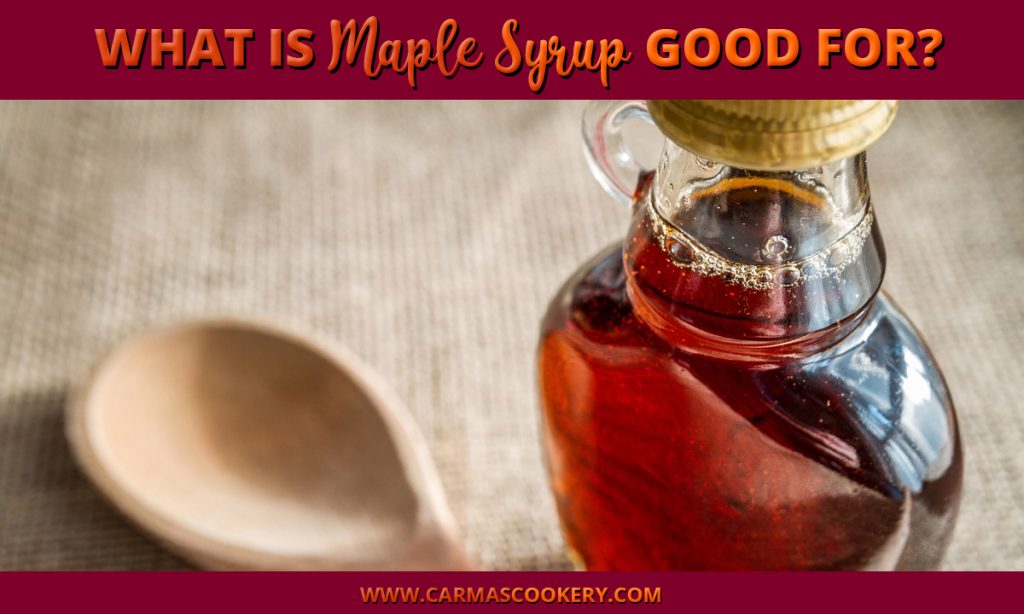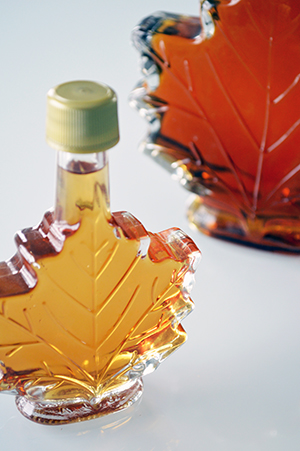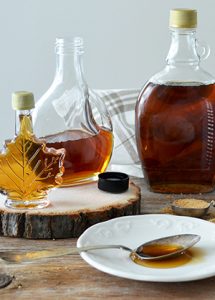When I was young, I thought maple syrup was for breakfast and nothing else. You poured it over the melting butter atop pancakes, waffles, or french toast, and that was it. But as I matured in my cooking skills, I discovered that there is a lot more that this condiment is good for.

Maple syrup is made from the sap of certain species of maple trees. The sap is originally very thin — about the consistency of water — and contains about 2% sugar. Maple farmers collect the sap and then thicken it through heating and evaporation.
Get Creative with Maple Syrup
 Although maple syrup makes a great breakfast syrup, it can also be used for other things. Here is a list of 10 of them. I hope it inspires your own creative uses.
Although maple syrup makes a great breakfast syrup, it can also be used for other things. Here is a list of 10 of them. I hope it inspires your own creative uses.
- Make maple butter. Simply, mix maple syrup into your butter until it appears whipped, then spread it on on your favorite bread, toast, cornbread, pumpkin bread … you name it!
- Use it to replace other sweeteners when you bake. You can use maple syrup to replace corn syrup, sugar, and other sweeteners while adding a touch of maple flavor. If using it to replace a dry sweetener, besides to reduce the amount of other liquids.
- Sweeten basic salad dressing. Add maple syrup to balsamic vinegar and olive oil, along with your favorite seasonings, for slightly sweeter salad dressing.
- Add to baked beans. Use maple syrup instead of brown sugar in your favorite baked beans recipe.
- Top your ice cream. Maple syrup can be just as good as any other syrup on your sundae. It tastes especially good with vanilla, pumpkin, or praline ice cream.
- Top cinnamon rolls. I’ve never liked all that icing on top of my cinnamon roll. But a drizzle of maple syrup could be quite nice.
- Sweeten sautéed veggies. Lots of fresh veggies go well with a little maple enhancement. Next time you want something different, try sautéing green beans or zucchini with a touch of maple syrup.
- Give pork chops a twist. Drizzle some maple syrup on top after they’re cooked, or make a maple reduction with the pan drippings and maple syrup.
- Simple soaked dessert. Soak plain donut holes or even cubes of bread in maple syrup overnight. Serve with heavy cream, straight or whipped. Add a sprinkling of cinnamon for panache.
- Drizzle over popcorn. Give your next movie night a fall-flavor! Toss in some cinnamon for extra zesty-ness.
Health Benefits of Maple Syrup
 The syrup of maple is not only good for sweetening things up, it can be part of a healthy lifestyle, too. It contains several nutrients which provide benefits to the body, including:
The syrup of maple is not only good for sweetening things up, it can be part of a healthy lifestyle, too. It contains several nutrients which provide benefits to the body, including:
- Manganese
- Zinc
- Potassium
- Calcium
- Riboflavin (B2)
- Magnesium
Let me explain the benefits of each one of these nutrients individually.
Manganese
Manganese plays a role in strengthening the immune system. It can also keep the brain healthy and supports normal nerve function. Because of its effect on the nervous system, it can calm the nerves and reduce stress, as well as depression. Drinking some maple syrup with warm water before you go to bed can enhance your sleep and so that you wake up feeling refreshed in the morning.
By consuming just one ounce of this condiment you can fulfill 22% the daily recommendation of manganese.
Zinc
Along with manganese, zinc plays a role in strengthening the immune system.
Consuming foods, such as maple syrup, that contain zinc may protect and prevent various cardiovascular disorders. It most likely does this because it enhances the performance of the endothelial cells that form the inner lining of blood vessels. If you have a low level of zinc in your body, these endothelial cells are more susceptible to injuries, which can affect the normal functioning of the heart.
Zinc is also beneficial to the male reproductive system, especially the prostate gland.
Potassium
Potassium plays a role in healthy brain function and helps prevent stroke. It also helps muscles function better, allowing for regular contraction and relaxation. This is why they say to eat a banana if you get leg cramps. (Hey! Maple syrup on a banana sounds good!)
It also may play a role in preventing or lowering the risk of diabetes. Research suggests that lower levels of potassium are associated with a higher risk of diabetes. One Johns Hopkins University study of healthy individuals found a link between low levels of potassium and high levels of insulin/glucose.
Potassium plays a role in bone health. Certain qualities of this mineral neutralize various acids in the body, helping the retention and preservation of calcium, in turn making calcium accessible for bone strength and durability.
Calcium
Speaking of calcium, not only is it vital for bone health, but it also works with potassium to make sure the muscles function properly. It plays a key role in blood clotting, as well. And it helps maintain the action of the heart muscle. Calcium relaxes the smooth muscle surrounding blood vessels. Research points to a possible link between lower blood pressure and high consumption of calcium.
Riboflavin (B2)
Because it cannot be stored in the body, we need to consume riboflavin daily. It plays a major role in energy production. It does this in two ways:
- By helping the conversion of carbohydrates to sugar, which fuels the body as a whole, and
- By playing an active part in the electron transport chain involved with cellular energy.
Riboflavin helps in process amino acids and fats and can serve as an antioxidant, which slows the pace of aging.
Magnesium
Much of your body’s functions depend on magnesium in one way or another. Approximately 60% of this mineral in your body is located in bone, and the rest is found in muscles, soft tissues, and fluids, including blood.
Magnesium plays a role in:
- Converting food into energy,
- Creating new proteins from amino acids,
- Creating and repairing DNA and RNA,
- Facilitating the contraction and relaxation of muscles, and
- Regulating neurotransmitters, the chemicals that send messages throughout your brain and nervous system.
Enjoy some maple syrup today!
Now that I’ve shared possibly everything you’ve ever wanted to know about maple syrup but were afraid to ask, I hope you’ll get creative and add some to your diet. But be sure it is the good stuff — if the label doesn’t say “pure maple syrup,” you won’t get any of the benefits listed above.


1 comments on “What is maple syrup good for?”